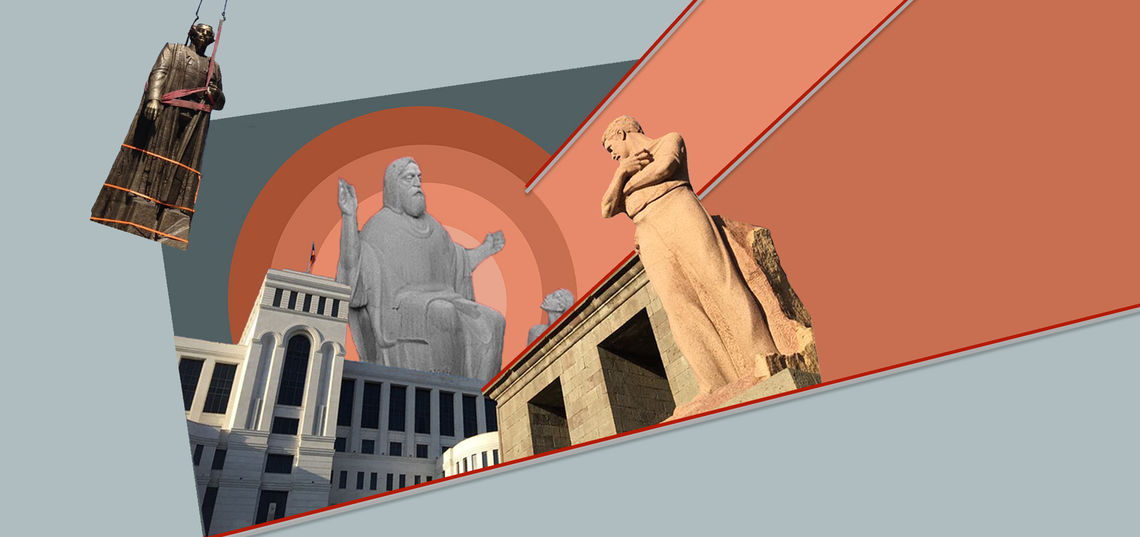Thu Apr 05 2018 · 11 min read
The Memory Gaps in Post-Independence Armenian History Textbooks

By Tigran Zakaryan

History textbooks are uniquely powerful tools in the hands of state elites for shaping people’s perceptions of their own past and, therefore, attitudes toward the present state of affairs.
As Marc Ferro, a renowned historian and seminal author of history textbooks states, “Our images of other people, or of ourselves for that matter, reflect the history we are taught as children.”[i]
National histories are narratives of the past with an aim to provide ready-made patterns proscribed by the elite to the mass of people, constituting the nation. What is within the narrative is equally and sometimes even more important than what is excluded from it. “Histories […] are based on memories organized into narratives. Whatever actually happened is far less important than how it is remembered. What is remembered, what has been forgotten or repressed, provides the template through which the world is understood,” writes R. G. Suny.[ii]
Armenian national historiography of the past several decades was dotted with memory gaps, because, among other reasons, the production of historical texts was in the tight grip of the Soviet state ideology. After Armenia’s independence, some topics previously repressed were revived and researched and found their way into the textbooks. However, there are still topics currently left out of national history textbooks for reasons to be discussed here.
Although Armenian history textbooks have become a topic of study only recently, a considerable amount of research has been done. So far, little attention however has been paid to what is missing or what is forgotten in them.
Forgetting for a Nation’s Sake
Forgetting is part of the memory of an individual and the same applies to human societies and nations in particular. French historian and philosopher Ernest Renan, in his much-celebrated speech titled, “What is a Nation?” (Qu’est-ce qu’une nation?), delivered in the Sorbonne in 1882, stated that a nation is a collective entity whose members share not only common memories but also common oblivion. “The essence of a nation is that all of its individual members have a great deal in common and also that they have forgotten many things,” he notes.[iii]
Armenian history is no exception. Having been part of the Soviet state for a long time, its past was colonized by the Soviet system, which, among other things, underlined the “special mission” of the Russian nation, which saved a number of nations from “servitude” and gave them a chance for national emancipation in a new socialist homeland.
It must be noted that gaps in Armenian history were not only for reasons stemming uniquely from Soviet ideological control. The history of marginal/minority religious, ethnic and other groups residing in Armenia were excluded from Armenian history because the very concept from long before Soviet times was centered around the nation, including the Armenian Apostolic Church. Some research on those groups, such as Catholic Armenians’ religious and educational activities in late medieval and early modern period, indicate a lack of inclusion in Soviet or post-Soviet history textbooks.
Paradoxes of Soviet and Armenian Post-Soviet Historiography
The official narrative of history in the Soviet Union underlined the missionary role of the Russian nation. However, it was not that simple. The Soviet state created a curious blend of both nationalist and colonial discourses, which suggested, on one hand, that the constituent non-Russian nations were doomed to be assimilated and merged into bigger empires (or, in the case of Armenians, even physically annihilated), and, at the same time admitting wrongdoings by “tsarism,” a euphemism used for “Russian colonialism.” The Russian people were invariably portrayed as “brotherly,” and this description sometimes extended to certain individuals and even high-ranking officials from the very “tsarist” regime.
The overall tone of the assessment of Armenian-Russian relations and the role the Russian Empire and Soviet Union played in the history of the Armenian nation is compromising, especially when one compares it with the tone of other former Soviet Republics’ history textbooks.
This narrative both legitimized Russian preeminence in the USSR and, to some extent, the national aspirations of constituent nations within the Soviet framework. (The Soviet state anthem, adopted in 1944, mentioned “Great Russia” within the first two lines, which “forged forever a union of free republics.”) Even after the downfall of the Soviet system, history textbooks were not too quick to fill in the gaps in their narratives.
The taboo topics following the fall of the Russian empire, creating of the independent republic and its conquest and partition by Soviet Russia and Turkey, an adequate account of the Soviet years were rather quick to find their way into the history books in order to reflect the new nationalist narratives, however, changes mainly stopped there. Moreover, the overall tone of the assessment of Armenian-Russian relations and the role the Russian Empire and Soviet Union played in the history of the Armenian nation is compromising, especially when one compares it with the tone of other former Soviet Republics’ history textbooks.
Modern Russian historian Marina Moiseykina singles out Armenian textbooks as showing Eastern Armenia’s joining Russia as “objectively accounted” while criticizing other former republics’ national history textbooks for “revisionism.” “In fact, all of them (with the exception of Belarus and partially Armenia) to some extent or another have nationalistic approaches to the history of Russia’s triumph (sic).”[iv]
Remembering Brotherhood, Forgetting Masterhood
The history of Armenian-Russian political interaction starts in the beginning of the 18th century when Peter the Great had plans to conquer the South Caucasus from the weakening Safavid Iran. However, Russia was unable to fulfill those plans single handedly as another powerful empire, the Ottoman, required their share of the booty.
Russia, based on its state interest and political realities of the time, on the one hand, activated pro-Russian sentiment among Armenians and Georgians under Iranian rule, while on the other, reached a compromise with the Ottomans, leaving fellow Christians under a new Muslim ruler and keeping the Caspian shore under its domination.
The tradition of using euphemisms is still present in the narrative of the beginning of the Soviet regime in Armenia. In a couple of cases we find the odd expression, “the unfavorable attitudes of the Soviet Russian leadership towards Armenians” in places where otherwise the simple term “anti-Armenian” is used, when, for instance, describing Azerbaijani diplomatic activities in 1918-1921.
The Constantinople Treaty of 1724 was an uneasy topic for Armenian historiography and textbooks portraying Russia as a friend. The treaty is reflected in post-independence, but, still uses euphemisms typical of the Soviet period, such as, “inability of the Russian troops to move further” rather than simply saying that it was directly agreed to by their own government, and that both the Ottoman and Russian empires “were trying to avoid conflict at all costs.” [v] On the whole, the impression is that even if presenting factual information, the 1724 Constantinople Treaty narrative surprisingly does not provide a chiefly Armenian perspective, as could be expected in a national history textbook and is less critical of the Russian policies than any other big power in the same position could be.
To prove that point, it is enough to compare critical remarks towards the European Great Powers in different passages, noting that they were “creating obstacles” for Russia to take over the Western part of Armenia in the 19th century, which, as the textbook rightfully asserts, could be a positive change in the life of the local Armenian population.
An interesting topic is the downfall of the first Armenian Republic in 1920 against the background of the alliance of Soviet Russia with Republican Turkey and the treaties of 1921 essentially partitioning Armenia between the two powers.
When tackling the Russian-Turkish alliance, the textbook often mentions its anti-Armenian aspects, however, in some instances one may observe a certain “blame shifting” by mentioning “anti-Armenian lobbying” rather than direct responsibility and political will behind Soviet Russia’s authorities for decisions clearly unfavorable for Armenia.[vi]
For instance, the fact that the Soviet Armenian delegation was not admitted as a party in the Moscow Treaty negotiations in February and March 1921 was explained by “the efforts of the Turkish side,” without explaining why the Soviet Russian government, which is said in the textbook, to have favored both Soviet Armenia’s and Azerbaijan’s participation in the talks, complied to Turkish demands. In the same section of the textbook, a passage says that Soviet Azerbaijan’s leadership was also involved in what can be called “pro-Turkey lobbying” before the Soviet leadership, however this hardly can be considered as a plausible explanation for excluding the Armenian delegation from talks.
Yet the textbook’s statement, “Neither Soviet Russia nor Kemalist Turkey had any right to make arrangements on Armenian territory without the participation of the Armenian party,” sounds only partially plausible. In reality, Soviet Armenia’s predecessor, the Armenian Republic was at war with the de-facto government of Turkey, so the Turkish Republic could definitely be a signatory party to such a document. Meanwhile, Soviet Russia’s signature in the document is more problematic, as it formally had no involvement in the conflict and Soviet Armenia was nominally an independent state.
The tradition of using euphemisms is still present in the narrative of the beginning of the Soviet regime in Armenia. In a couple of cases we find the odd expression, “the unfavorable attitudes of the Soviet Russian leadership towards Armenians” in places where otherwise the simple term “anti-Armenian” is used, when, for instance, describing Azerbaijani diplomatic activities in 1918-1921.
The textbook also mentions several representatives of the Soviet Armenian leadership as “preoccupied with Armenian national issues” during the Soviet regime. However, we do not clearly see what odds they were fighting against and what messages they received or sanctions they faced from Moscow for their nationalist activities.
The national policies of the Soviet authorities are rather blurred in the picture, although they are represented in a negative tone.
There is little attempt to explain to students why Armenia, like any other constituent republic in the Soviet Union had very limited self-governance, let alone sovereignty.
In two consecutive pages, the ninth grade history textbook says that the “sovereignty of the [constituent] republics [in the Transcaucasian Soviet Federative Socialist Republic] was very limited” and that, according to the USSR Treaty, the Republics had to “maintain their sovereignty.” The authors fail to explain the reasons for this discrepancy between reality and paper.
These are only a few examples of the overall pattern, which generally can be said to be adjusted to the current patterns of the relationship between Armenia and Russia, on the one hand, and on the currently circulating nationalist mythological patterns, on the other.
Forgetting the “Others”
While Armenian textbooks are not full of genuinely hostile rhetoric against foreign invaders or neighbors, they contain obvious gaps in their narratives on the presence of “others,” who could include non-Apostolic Armenians and non-Armenians.
In some historical periods, there was a significant presence of Muslim populations and rulers in different Armenian localities.
All standard Armenian history textbooks mention that ethnic Armenians were less than half of the population of Eastern Armenia, particularly of the Yerevan Khanate, on the eve of its occupation by Russia (1828).
We find little interest in non-Armenians in the Cilician kingdom, though it is known that Armenians were the predominant ethnic element in the kingdom throughout its existence. Yet non-Armenians constituted a significant part of the population.
All these facts are tackled superficially. The presence of the Muslim population in Eastern Armenia is currently used by the modern state-controlled Azerbaijani historiography to justify claims to Karabakh and other Eastern Armenian territories. By discarding that part of Armenia’s history, Armenian historiography would agree with the theory that the Muslim people residing in Armenia had any Azerbaijani identity, but this fact makes Armenians’ right to their own territory weaker.
This tendency is also projected to the Muslim entities in Armenia of earlier periods. The Muslim/Arab political entities (emirates) starting from the Arab rule in Armenia and existing during the Bagratid Dynasty are hardly mentioned in the textbooks, and there’s no mention of emirate in Khlat in the 12th and early 13th centuries in most of the textbooks. It was known and established by Armenian academic historiography that the title Sharamen (Shah-i-Arman), or “king of the Armenians,” was an official title of the Khlat emirate, and that it probably had predominantly Armenian ethnic composition, including some Armenian semi-dependent principalities (they are mentioned but independent from their lords) and that even some of their rulers were Armenian converts to Islam.
We find little interest in non-Armenians in the Cilician kingdom, though it is known that Armenians were the predominant ethnic element in the kingdom throughout its existence. Yet non-Armenians (ethnic minorities if we use the term in its much later context) constituted a significant part of the population.
Ethnic Brethren, Religious Others
Another important void in Armenian history textbooks is the flagrant absence of non-Gregorian Armenians, with some notable exceptions. Catholic Armenians, for instance, were mentioned in exceptional cases (their exile from Constantinople or when tackling the Mkhitarist Congregation) but not as a community. The Armenian Catholic cultural and educational activities in late medieval period (15-17th centuries and later), Armenian Catholic principalities in northwest Iran are completely out of the scope of history.
This kind of “tight-lipped” religious segregation discourse seems quite pre-modern and dominated by the Armenian Apostolic Church, which undeniably enjoys a solid and even more solidifying influence in society and the education system.
Soviet Armenian historiography to some extent researched a unique Armenian state formation of the Maku/Artaz principality, which existed in the 13th to mid-14th century on the territory of current Iran, whose rulers were mostly Catholic. The convent of Tzortzor in the principality became a uniquely important center of education and scholarship, where European medieval authors were translated into Armenian. This history is, to some extent, covered by traditional Armenian academic history, but that research is not integrated into history textbooks.
This is similar to the Protestant Armenian community in the Ottoman Empire and Muslim Armenians (Hamshentsi and others).
By covering those gaps in history, it would be easier and more acceptable to create an environment of religious tolerance in today’s Armenia and provide a chance for Armenians of all religious backgrounds to show national solidarity.
This kind of “tight-lipped” religious segregation discourse seems quite pre-modern and dominated by the Armenian Apostolic Church, which undeniably enjoys a solid and even more solidifying influence in society and the education system.
To summarize, modern Armenian history textbooks still have important gaps in their narratives, mainly due to a legacy from the Soviet, and pre-Soviet pasts as well as current internal and external political situations. The Armenian state needs to pay more attention to textbook production and support efforts aimed at detaching historical narratives from old ecclesiastic and colonized patterns.


